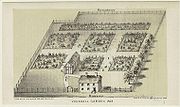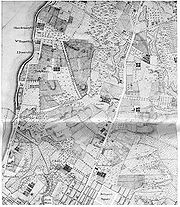
New York Vauxhall Gardens
Encyclopedia

New York City
New York is the most populous city in the United States and the center of the New York Metropolitan Area, one of the most populous metropolitan areas in the world. New York exerts a significant impact upon global commerce, finance, media, art, fashion, research, technology, education, and...
. It was named for the Vauxhall Gardens
Vauxhall Gardens
Vauxhall Gardens was a pleasure garden, one of the leading venues for public entertainment in London, England from the mid 17th century to the mid 19th century. Originally known as New Spring Gardens, the site was believed to have opened before the Restoration of 1660 with the first mention being...
of London. Though the venue passed through a long list of owners, and suffered buyouts, closings, relocations, and re-openings, it lasted until the mid-19th century.

Samuel Fraunces
Samuel Fraunces was the owner/operator of Fraunces Tavern in New York City. During the American Revolution, he provided for prisoners held during the British occupation, and may have been a spy for the American side...
opened the New York Vauxhall in 1767 to take advantage of this climate, and it received a chief competitor in the New York Ranelagh Gardens, which appear on Bernard Ratzer
Bernard Ratzer
Bernard Ratzer was an American cartographer, best known for his 18th century maps of early New York City. Today, his name is invoked as something of a DaVinci of New York cartography, as his best known work was the 1770 "Plan of the City of New York"....
's map of New York of 1767 (illustration. left), occupying a wooded rise of ground just north of the northernmost city houses, on the south side of Duane Street; the site overlooked Lispenard's Meadows and the riverfront road to Greenwich Village
Greenwich Village
Greenwich Village, , , , .in New York often simply called "the Village", is a largely residential neighborhood on the west side of Lower Manhattan in New York City. A large majority of the district is home to upper middle class families...
. The original Vauxhall Gardens were located in a more confined space on Greenwich Street near the Hudson River
Hudson River
The Hudson is a river that flows from north to south through eastern New York. The highest official source is at Lake Tear of the Clouds, on the slopes of Mount Marcy in the Adirondack Mountains. The river itself officially begins in Henderson Lake in Newcomb, New York...
between what later became Warren and Chambers
Chambers Street (Manhattan)
Chambers Street is a bi-directional street in the New York City borough of Manhattan. It runs from River Terrace, Battery Park City, in the west, past PS 234 and Stuyvesant High School to 1 Centre Street, the Manhattan Municipal Building, to the east. In the early 20th century the street...
streets in the fashionable Sixth Ward; New York Public School 234 stands at the site today. Ratzer's map shows its square garden plot, conventionally divided in four by walks. Fraunces operated the venue until 1773, when he offered it for sale. His notice mentioned two large gardens, a house with four rooms per floor and twelve fireplaces, and a dining hall that was 56 feet (17.1 m) long and 26 feet (7.9 m) wide, with a kitchen below. The Vauxhall offered light summer concerts and featured an outdoor wax museum
Wax museum
A wax museum or waxworks consists of a collection of wax sculptures representing famous people from history and contemporary personalities exhibited in lifelike poses....
. For the summer 1768 season, it hosted an exhibit on the life of Scipio Africanus
Scipio Africanus
Publius Cornelius Scipio Africanus , also known as Scipio Africanus and Scipio the Elder, was a general in the Second Punic War and statesman of the Roman Republic...
that included a grove with a reconstruction of the military leader at his tent. The Vauxhall remained popular throughout the Colonial period of New York
History of New York City (1665-1783)
The history of New York City began with the establishment of English rule over Dutch New Amsterdam and New Netherland. As the newly renamed City of New York and surrounding areas developed, there was a growing independent feeling among some, but the area was decidedly split in its loyalties...
and to the end of the 18th century. By this point, the gardens had two namesake competitors, one of which was primarily popular for its ice cream
Ice cream
Ice cream is a frozen dessert usually made from dairy products, such as milk and cream, and often combined with fruits or other ingredients and flavours. Most varieties contain sugar, although some are made with other sweeteners...
.
As New York City expanded, streets of rowhouses with rear gardens swallowed the site. In 1798, owner Joseph Delacroix moved his operations to Broome Street between Broadway
Broadway (New York City)
Broadway is a prominent avenue in New York City, United States, which runs through the full length of the borough of Manhattan and continues northward through the Bronx borough before terminating in Westchester County, New York. It is the oldest north–south main thoroughfare in the city, dating to...
and the Bowery
Bowery
Bowery may refer to:Streets:* The Bowery, a thoroughfare in Manhattan, New York City* Bowery Street is a street on Coney Island in Brooklyn, N.Y.In popular culture:* Bowery Amphitheatre, a building on the Bowery in New York City...
. In 1805, it moved yet again, this time to Lafayette Street
Lafayette Street (Manhattan)
Lafayette Street is a major north-south street in New York City's Lower Manhattan, which runs roughly parallel to Broadway to the west. Originally, the part of the street below Houston Street was called Elm Place....
, stretching from 4th
West 4th Street (Manhattan)
West Fourth Street runs east-west through most of eastern and central Manhattan and then turns north at Sixth Avenue to intersect with West 10th, 11th, 12th, and 13th Streets in Greenwich Village...
to 8th
Eighth Street (Manhattan)
Eighth Street is a street in the New York City borough of Manhattan that runs from Sixth Avenue to Third Avenue, and Avenue B to Avenue D; it switches from west to east at Fifth Avenue. Between Third Avenue and Avenue A, the position in the grid that would be occupied by Eighth Street is known as...
streets in what were then the northern reaches of the city, the area that later became Astor Place
Astor Place (Manhattan)
__notoc__Astor Place is a short two-block street in lower Manhattan, New York City, which runs from Broadway just below East 8th Street, through Lafayette Street, past Cooper Square and Fourth Avenue, and ends at Third Avenue and St. Marks Place. The name is also used for the neighborhood around...
, 4th Street, Broadway, and the Bowery. Professional travel writer John Lambert visited in November 1807 and wrote,
New York has its Vauxhall and Ranelagh; but they are poor imitations of those near London. They are, however, pleasant places of recreation for the inhabitants. The Vauxhall garden is situated in the Bowery Road about two miles (3 km) from the City Hall. It is a neat plantation, with gravel walks adorned with shrubs, trees, busts, and statues. In the centre is a large equestrian statue of General Washington. Light musical pieces, interludes, etc. are performed in a small theatre situate in one corner of the gardens: the audience sit in what are called the pit and boxes, in the open air. The orchestra is built among the trees, and a large apparatus is constructed for the display of fireworks. The theatrical corps of New York is chiefly engaged at Vauxhall during summer….
The theater's boxes faced the garden and blocked the stage from the street.
The area belonged to John Jacob Astor
John Jacob Astor
John Jacob Astor , born Johann Jakob Astor, was a German-American business magnate and investor who was the first prominent member of the Astor family and the first multi-millionaire in the United States...
. In 1826, he carved out an upper-class neighborhood from the site with Lafayette Street
Lafayette Street (Manhattan)
Lafayette Street is a major north-south street in New York City's Lower Manhattan, which runs roughly parallel to Broadway to the west. Originally, the part of the street below Houston Street was called Elm Place....
bisecting eastern gardens from western homes. Wealthy New Yorkers, including Astor and other members of the family, built mansions along this central thoroughfare. Astor built the Astor Library
New York Public Library
The New York Public Library is the largest public library in North America and is one of the United States' most significant research libraries...
in the eastern portion of the neighborhood as a donation to the city. Architect Seth Geer designed eye-catching row house
Terraced house
In architecture and city planning, a terrace house, terrace, row house, linked house or townhouse is a style of medium-density housing that originated in Great Britain in the late 17th century, where a row of identical or mirror-image houses share side walls...
s called LaGrange Terrace for the development, and the area became a fashionable, upper-class residential district.
This location made the gardens accessible to the people of both the Broadway and Bowery districts. In the summer of 1838, the owners opened a saloon for the staging of vaudeville
Vaudeville
Vaudeville was a theatrical genre of variety entertainment in the United States and Canada from the early 1880s until the early 1930s. Each performance was made up of a series of separate, unrelated acts grouped together on a common bill...
comic operas. Later theatre managers expanded the offerings to appeal to a wider range of patrons. By 1850, the rowdier crowds of the Bowery had mostly scared off the upper classes, and revenues suffered. The theater buildings were demolished in 1855, and the gardens closed for the last time in 1859.

